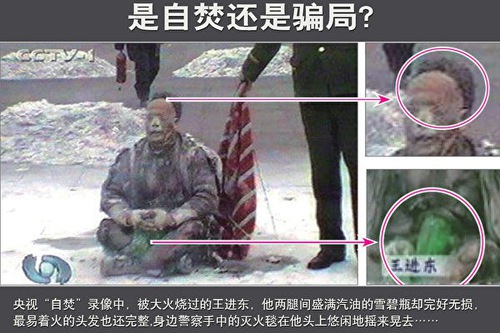(Minghui.org) I used to be a news photographer. Later I became a professional cinematographer and film light engineer and have worked in this field for over 10 years in North America.
Compared to being a news photographer, a professional cinematographer has certain advantages because one can set up the scene, the actors or actresses are well prepared, and the cameras can be placed from various angles at various distances.
Given my professional knowledge, it’s very clear to me that the self-immolation incident on Tiananmen Square “reported” by the China Central Television (CCTV) on January 23, 2001 was staged to defame Falun Gong, instead of actual news coverage.
Well-Designed Setting
It was New Year’s Eve, a time of family reunion and happiness, on January 23, 2001. While families were having their holiday dinners together, the CCTV broadcast the “breaking news” that several Falun Gong practitioners had set themselves on fire on Tiananmen Square, including a young girl who had accompanied her mother. The news was played again and again, leaving countless families in shock, fear, and anger. They had no room to analyze the situation, but were forced to take in the narrative designed by the communist regime.
Although this was supposed to be “breaking news” coverage, one can easily spot many professional filmmaking techniques in the footage. At the beginning of the footage was a scene shot from high above. Apparently the cameramen found a vantage point with a perfect shooting angle to show the “full picture” to the viewers.
After enough distant shots, the camera slowly zoomed in. From the degree of stability, one can tell the video camera was placed on a tripod. Facing such emergencies, a cameraman would definitely hold the camera. This is because if the cameraman takes out the tripod, sets it up, and puts the camera on it, many key moments would be missed. Plus, handheld shooting can maintain the flexibility of the camera, but this could not achieve the stability shown in the CCTV footage.
Carefully Designed Plot
In the movie Saving Private Ryan, director Steven Spielberg intentionally shook the camera to simulate the effect of a battlefield during the Normandy invasion.
As a news photographer and cameramen myself, I know the pressure and urgency when shooting breaking news or major events. One must react very fast and precisely. It’s usually an all-or-nothing moment. But in the Tiananmen Square self-immolation incident mentioned above, however, it appeared to me that the cameramen was very calm as if he was clear what would happen next and what needed to be captured from which position. I didn’t see any sense of urgency about missing the scene of an emergency, and it was smoothly switched to the next scene in which an alleged Falun Gong practitioner, Wang Jindong, called out slogans.
In this set, a panoramic view was shown in the beginning so that the audience would see that Wang was doing meditation. In actuality, his position was like that of a Chinese soldier and different from the meditation of Falun Gong.
 Screenshot in False Fire: Wang had a Sprite bottle between his legs which reporters claimed contained gasoline. Although his pants and winter coat were burned, his hair and the plastic Sprite bottle, the two most flammable things, did not change color or shape.
Screenshot in False Fire: Wang had a Sprite bottle between his legs which reporters claimed contained gasoline. Although his pants and winter coat were burned, his hair and the plastic Sprite bottle, the two most flammable things, did not change color or shape.
In real fire emergencies, firefighters race against time to save people. But in the close-up footage, a police officer stood behind Wang with a fire-extinguishing blanket, but he didn’t put the blanket on him until he finished shouting slogans that claimed that the reason for his self-immolation was because of Falun Gong. Their actions were well-timed and coordinated with the movement of the camera.
There are so many more loopholes in the footage. Interested readers can watch a detailed analysis video called False Fire.
Long-lasting Negative Impact
For a regular movie, the release time after the post-production is critical. This determines the box office and the audience groups. For example, whether it is part of the Summer Release or New Year Release.
Producers of the CCTV’s self-immolation video worked very hard to complete this political task. Because the audience are citizens all over China, they picked the eve of Chinese New Year, when nearly every family was gathering in front the television in happiness. By including a young girl, a college student, and the elderly in the plot, they successfully grabbed the attention of people from all ages and turned them against innocent Falun Gong practitioners.
Although 23 years have passed, the self-immolation is still the first thing many Chinese people think of when Falun Gong is mentioned. The deep hatred and fear they developed against Falun Gong because of the self-immolation incident is long lasting and hard to undo, even with clear evidence.
Summary
The thousands of years of Chinese history focused on moral values. This is opposite of the hatred, brutality, and lies that the Chinese Communist Party (CCP) promotes. This is why after the regime took power in 1949, it launched numerous political campaigns to destroy traditional Chinese culture.
After Falun Gong was introduced to the public in 1992, its principles of Truthfulness-Compassion-Forbearance and five sets of exercises improved both mind and body for tens of millions of people. The widespread popularity of the practice is also why the CCP exhausted all its resources to target the group with propaganda and torture.
In doing so, the CCP has pitted Chinese people against traditional values, leading China on a path of uncertainty and danger. We hope more people will learn the facts and know the real story by reading this page, with additional information and videos, which lay out the evidence that the self-immolation incident was, in fact, a hoax.
All content published on this website is copyrighted by Minghui.org. Minghui will produce compilations of its online content regularly and on special occasions.










